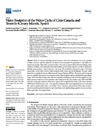Identificador persistente para citar o vincular este elemento:
https://accedacris.ulpgc.es/handle/10553/114510
| Campo DC | Valor | idioma |
|---|---|---|
| dc.contributor.author | Cruz-Pérez, Noelia | en_US |
| dc.contributor.author | Santamarta, Juan C. | en_US |
| dc.contributor.author | García-Gil, Alejandro | en_US |
| dc.contributor.author | Rodríguez-Martín, Jesica | en_US |
| dc.contributor.author | Miralles-Wilhelm, Fernando | en_US |
| dc.contributor.author | Hernández Alemán, Anastasia | en_US |
| dc.contributor.author | Aldaya, Maite M. | en_US |
| dc.date.accessioned | 2022-04-29T08:31:09Z | - |
| dc.date.available | 2022-04-29T08:31:09Z | - |
| dc.date.issued | 2022 | en_US |
| dc.identifier.issn | 2073-4441 | en_US |
| dc.identifier.other | Scopus | - |
| dc.identifier.uri | https://accedacris.ulpgc.es/handle/10553/114510 | - |
| dc.description.abstract | When it comes to exploiting natural resources, islands have limitations due to the quantity of these resources and the potential for harm to the ecosystem if exploitation is not done in a sustainable manner. This article presents a study of the water footprint of the different drinking water collection facilities and wastewater treatment facilities in the Canary Islands, in order to determine the blue, green, and grey water footprints in each case. The results show high percentages of drinking water losses, which raises the blue water footprint of the Canary Islands archipelago. The grey water footprint was studied in terms of Biochemical Oxygen Demand (BOD5 ). The green water footprint was not considered because it is a dimension of the water footprint mainly calculated for agricultural crops. Of the facilities studied, the wells for extraction of drinking water from the aquifer and the distribution network have the largest blue water footprint for the years under study (2019 and 2020). Only the wastewater treatment plants have a gray water footprint in this study, with values between 79,000 and 108,000 m3 per year. As a general conclusion, the most important factor in reducing the water footprint of the water cycle in the Canary Islands is optimization of the water resource, improving existing infrastructures to minimize losses, and implementing a greater circular economy that reuses water on a regular basis. | en_US |
| dc.language | eng | en_US |
| dc.relation.ispartof | Water (Switzerland) | en_US |
| dc.source | Water (Switzerland) [EISSN 2073-4441], v. 14 (6), 934, (Marzo 2022) | en_US |
| dc.subject | 2508 Hidrología | en_US |
| dc.subject | 531201 Agricultura, silvicultura, pesca | en_US |
| dc.subject.other | Climate Change | en_US |
| dc.subject.other | Desalination | en_US |
| dc.subject.other | Volcanic Islands | en_US |
| dc.subject.other | Water Galleries | en_US |
| dc.subject.other | Water Supply | en_US |
| dc.title | Water footprint of the water cycle of Gran Canaria and Tenerife (Canary Islands, Spain) | en_US |
| dc.type | info:eu-repo/semantics/article | en_US |
| dc.type | Article | en_US |
| dc.identifier.doi | 10.3390/w14060934 | en_US |
| dc.identifier.scopus | 85127364252 | - |
| dc.contributor.orcid | NO DATA | - |
| dc.contributor.orcid | NO DATA | - |
| dc.contributor.orcid | NO DATA | - |
| dc.contributor.orcid | NO DATA | - |
| dc.contributor.orcid | NO DATA | - |
| dc.contributor.orcid | NO DATA | - |
| dc.contributor.orcid | NO DATA | - |
| dc.contributor.authorscopusid | 57218766723 | - |
| dc.contributor.authorscopusid | 55203666100 | - |
| dc.contributor.authorscopusid | 23011954700 | - |
| dc.contributor.authorscopusid | 57218760942 | - |
| dc.contributor.authorscopusid | 6603172173 | - |
| dc.contributor.authorscopusid | 56156123100 | - |
| dc.contributor.authorscopusid | 35316963700 | - |
| dc.identifier.eissn | 2073-4441 | - |
| dc.identifier.issue | 6 | - |
| dc.relation.volume | 14 | en_US |
| dc.investigacion | Ciencias Sociales y Jurídicas | en_US |
| dc.type2 | Artículo | en_US |
| dc.description.notas | This article belongs to the Section Water Use and Scarcity | en_US |
| dc.utils.revision | Sí | en_US |
| dc.date.coverdate | Marzo 2022 | en_US |
| dc.identifier.ulpgc | Sí | en_US |
| dc.contributor.buulpgc | BU-ECO | en_US |
| dc.description.sjr | 0,723 | |
| dc.description.jcr | 3,4 | |
| dc.description.sjrq | Q1 | |
| dc.description.jcrq | Q2 | |
| dc.description.scie | SCIE | |
| dc.description.miaricds | 10,6 | |
| item.fulltext | Con texto completo | - |
| item.grantfulltext | open | - |
| crisitem.author.dept | GIR TIDES: Economía, medioambiente, sostenibilidad y turismo | - |
| crisitem.author.dept | IU de Turismo y Desarrollo Económico Sostenible | - |
| crisitem.author.parentorg | IU de Turismo y Desarrollo Económico Sostenible | - |
| crisitem.author.fullName | Hernández Alemán, Anastasia | - |
| Colección: | Artículos | |
Citas SCOPUSTM
6
actualizado el 08-jun-2025
Citas de WEB OF SCIENCETM
Citations
6
actualizado el 08-jun-2025
Visitas
128
actualizado el 01-mar-2025
Descargas
206
actualizado el 01-mar-2025
Google ScholarTM
Verifica
Altmetric
Comparte
Exporta metadatos
Los elementos en ULPGC accedaCRIS están protegidos por derechos de autor con todos los derechos reservados, a menos que se indique lo contrario.
